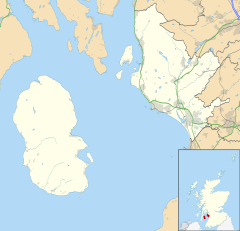
The Islands of the Firth of Clyde are the fifth largest of the major Scottish island groups after the Inner and Outer Hebrides, Orkney and Shetland. They are situated in the Firth of Clyde between Ayrshire and Argyll and Bute. There are about forty islands and skerries. Only four are inhabited, and only nine are larger than 40 hectares. The largest and most populous are Arran and Bute. They are served by dedicated ferry routes, as are Great Cumbrae and Holy Island. Unlike the isles in the four larger Scottish archipelagos, none of the isles in this group are connected to one another or to the mainland by bridges.

Lamlash is a village on the Isle of Arran, in the Firth of Clyde, Scotland. It lies three miles south of the island's main settlement and ferry port Brodick, in a sheltered bay on the island's east coast, facing the Holy Isle. Lamlash is the seat of Arran's local government offices, and is also the location of the island's police station, secondary school and hospital. In common with the rest of the island, the village's main industry is tourism and the public sector is also an important employer. Lamlash has an RNLI Lifeboat station with a B class Atlantic 75 lifeboat, covering the inshore waters around the coast of Arran, and in summer, there is a regular ferry service from Lamlash harbour to Holy Isle. The village has several buildings of historical interest, including Hamilton Terrace, which consists of two rows of single storey-and-attic cottages on the Lamlash seafront, arranged in pairs.

The Holy Island or Holy Isle is an island in the Firth of Clyde, off the west coast of central Scotland, inside Lamlash Bay on the larger Isle of Arran. The island is around 3 kilometres long and around 1 kilometre wide. Its highest point is the hill Mullach Mòr.

The County of Bute, also known as Buteshire, is a historic county and registration county of Scotland.

Seil is one of the Slate Islands, located on the east side of the Firth of Lorn, 7 miles southwest of Oban, in Scotland. Seil has been linked to the mainland by bridge since the late 18th century.
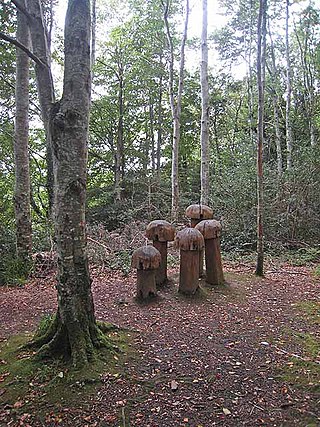
Hazelwood is an ancient area of woodland located just over 2 miles (3.2 km) outside the town of Sligo in northwest Ireland, in the parish of Calry. It is the setting for W.B.Yeats's The Song of Wandering Aengus. The wood is situated on the shores of Lough Gill, which contains Yeats's Lake Isle of Innisfree, and is popular for its scenic walks, which are dotted with sculptures. Swans, mallards and gulls congregate at the picnic area, and there is fishing on Lough Gill. The wood is part of the Hazelwood estate, owned by the Wynne family for two hundred years. The walk along forests trails provides views of the lake and Church Island, Cottage Island and Goat Island.
The Arran whitebeams are species of whitebeam endemic to the island of Arran, Ayrshire, Scotland.

Pirnmill is a small village on the north-west coast of the Isle of Arran, Scotland. The village is situated on the Kilbrannan Sound, facing Grogport on the Kintyre peninsula.
Pabay is a Scottish island just off the coast of Skye. The name Pabay is derived from an old Norse word meaning "priest's isle" and there are the remains of a 13th-century chapel.
Hedlundia pseudomeinichii, known as false rowan and Catacol whitebeam, is a rare species of tree endemic to the Isle of Arran in south-western Scotland. It is believed to have arisen as a hybrid of the native European rowan and the cut-leaved whitebeam which is in turn a rowan/Arran whitebeam hybrid. Until 2020, only one living specimens of the Catacol whitebeam was known, at the time making it the rarest tree not only in Scotland, but joint rarest in the world with Wood's cycad. Another was recorded as a sapling, but is believed to have been destroyed by deer. A seedling and grafted plants have also been grown in Edinburgh.

Hedlundia arranensis, sometimes referred to as the Scottish or Arran whitebeam, is a species of plant in the family Rosaceae. It is endemic to the island of Arran in Scotland.
Culbone is a hamlet consisting of little more than the parish church and a few houses, in the parish of Oare in the Exmoor National Park, Somerset, England. As there is no road access it is a two-mile walk from Porlock Weir, and some four miles from Porlock itself.
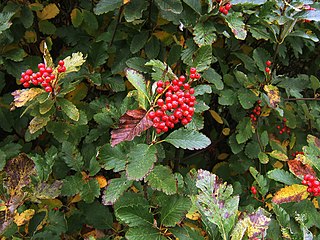
Sorbus mougeotii, the Vosges whitebeam or Mougeot's whitebeam, is a species of whitebeam native to the mountains of central and western Europe from the Pyrenees east through the Alps to Austria, and north to the Vosges Mountains.

The flora of Scotland is an assemblage of native plant species including over 1,600 vascular plants, more than 1,500 lichens and nearly 1,000 bryophytes. The total number of vascular species is low by world standards but lichens and bryophytes are abundant and the latter form a population of global importance. Various populations of rare fern exist, although the impact of 19th-century collectors threatened the existence of several species. The flora is generally typical of the north-west European part of the Palearctic realm and prominent features of the Scottish flora include boreal Caledonian forest, heather moorland and coastal machair. In addition to the native species of vascular plants there are numerous non-native introductions, now believed to make up some 43% of the species in the country.
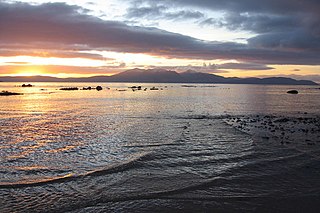
The Isle of Arran or simply Arran is an island off the west coast of Scotland. It is the largest island in the Firth of Clyde and the seventh-largest Scottish island, at 432 square kilometres (167 sq mi). Historically part of Buteshire, it is in the unitary council area of North Ayrshire. In the 2011 census it had a resident population of 4,629. Though culturally and physically similar to the Hebrides, it is separated from them by the Kintyre peninsula. Often referred to as "Scotland in Miniature", the Island is divided into highland and lowland areas by the Highland Boundary Fault and has been described as a "geologist's paradise".

Scotland is ideal for tree growth, thanks to its mild winters, plentiful rainfall, fertile soil and hill-sheltered topography. As of 2019 about 18.5% of the country was wooded. Although this figure is well below the European Union (EU) average of 43%, it represents a significant increase compared to the figure of 100 years previously: in 1919 it was estimated that only 5% of the country's total land area was covered in forest. The Scottish Government's Draft Climate Change Plan has set an aim of increasing coverage to 21% of Scotland by 2032, with the rate of afforestation rising to 15,000 hectares per year by 2024.
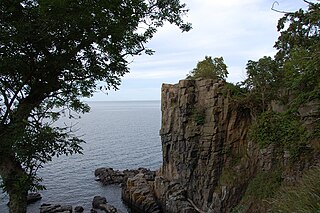
Helligdomsklipperne are a group of rocks on the island of Bornholm, Denmark, 6 kilometres (3.7 mi) from Gudhjem and 4.9 kilometres (3.0 mi) from Tejn. They are characterised by moderately high coastal cliffs of sharp granite and are about 22 metres (72 ft) high. The name of the rocks originated in the Middle Ages when there was a holy spring close to the coast which attracted pilgrims, especially on Sankt Hans Aften. During the ice age, much of today's coast was below sea level but when the ice melted, the island itself was raised leaving this part of Bornholm's coast some 20 meters above sea level. Coastal cliffs with deep caves and steep craggy granite pillars are typical of this area of the coast as a result of many years exposure to the weather. To the southeast the Kyststi or coastal path leads to the well preserved Døndalen Woods. It is a popular tourist attraction, accessed by boats from Gudhjem harbour. Steps lead from the coast up to the Bornholm Art Museum.

Catacol Bay is a small shallow-curved tidal, 310° facing, rocky coastal embayment located on the northwest tip of the Isle of Arran in the Firth of Clyde, within the council area of North Ayrshire in Scotland.

Hedlundia is a genus of plants in the rose family. They are shrubs or small trees that have a hybrid origin involving crosses between Aria and Sorbus sensu stricto. There are about 48 species are distributed across central, western and southern Europe, Scandinavia, Turkey, the Caucasus, Crimea, and also central Asia. The term Hedlundia was published in 2017.

